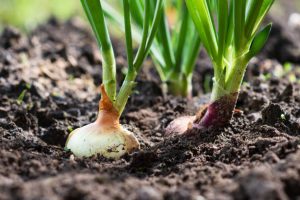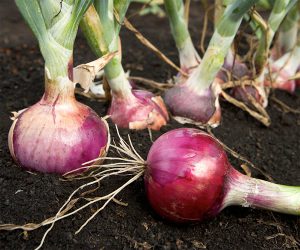Onion farming is the process of growing an onion while following the sequence of tips, techniques, and steps. This article covers everything from sowing to soil preparation and checking climate conditions.
Cultivation of Onion – Brief introduction to sowing, plantation, irrigation, crop rotation and marketing of onion farming
Onion is one ingredient that is used in every household globally. Do you want to know in detail the unique aspects and factors of onion farming? You’ve come to the correct page; we will take you through a step-by-step guide on onion cultivation. Let’s dive into the directory.
Table of Contents
Onion farming from Planting to Harvesting
Suitable climate condition for Onion farming
Preparation of soil for the Onion farming
Harvest, Marketing, and Storage of Onion Vegetables
- Which soil is perfect for onion farming?
- What is nursery raising and onion seed rate per hectare?
- How to germinate the onion seeds indoors?
- Does the cultivation of onion require lots of water to grow?
Introduction to Onion farming

Onion is found in every household and is a multipurpose vegetable worldwide. The onion farming business is ancient, profitable, and easy to follow. The bulk of farmers adopt the global cultivation of onions. Onion cultivation is accessible in several ways, including less care, attaining a good profit margin, and requiring less capital investment. In 2019, the worldwide production of onion was recorded as 4.5 million tonnes.
China is the number one country in onion production, holding 22% of the total output. South Korea, Mali, and Japan are in the next list of largest producers of onion farming.
Various varieties in onion farming define the quality and production of onion. The color and quality of the onion also change the protein, carbohydrates, and sulfur percentage. Let’s read about the aspects and factors of onion farming.
Onion Seed rate
7 – 9 kg/ha.
(note: 1 ha = 2.48 acres)
Suitable climatic condition for Onion farming
Onion farming has multiple stages; each step requires a different temperature set. The best development of the onion crop is expected in mild weather, not so warm, cold, dry or rainfall. The first stage, called the vegetable stage, requires 13-24 degrees, then for the bulbing stage 16-21 degrees, the last stage called maturity, and around harvesting onion needs 30-35 degrees.
Let’s know about the cultivation of onions in different seasons.
- Rabi season – October to April
- Kharif season – May to September
- Late Kharif season – August to February
Soil preparation
Preparing soil includes mixing FYM, vermicompost, and poultry manure for high-yield produce. Make the soil fine by ploughing the land and mixing the manure and vermicompost into the soil. Inculcate FYM 20 tonnes/ha or 10 tonnes FYM or 5 tonnes vermicompost to increase the fertility and incorporate the organic compound in soil.
Form the Broad-bed or Flatbed furrow for planting the seeds with a uniform gap. The spacing must be 15x 10 cm for both beds.
Now, take 100% of P, K, and S along with 50% of N and after 30-45 days after transplanting, apply the remaining 50% of N in different splits. The dressing by these components must be completed before the bulbing phase ends.
Water management in Onion crop
Water is essential for the growth of high-quality onions. Irrigation is needed at the time of sowing, transplanting followed by light irrigation on the third day of plantation and regular irrigation from seven to ten days while assessing the need for moist soil. The right amount of watering strengthens the roots and allows the organic compound to nourish the production.
Typically the onion plants require 30 inch irrigation close to the harvest and growing season. Less water can result in smaller bulbs of onion and less nutritious results. When the neck falling stage starts, irrigation must stop and let the soil dry completely and expect the production.
Harvest, Marketing and Storage of Onion

While harvesting the onion, its neck fall stage must be 50%. The harvesting is performed right after the maturity stage. The storage life of onion bulbs is about 5-6 months in a suitable storage place. The storage must be fully-equipped and developed to keep the onion fresh and ready to ship anytime needed.
Harvesting at the right time is necessary to avoid issues like thick-neck bulbs, respiration, and disease, extra sprouting, and sunburn due to leaving for a long time in the sun.
Heavy head onion crops are kept from two to three days in the field and 3-4 days to drain the extra moisture in the product. This leftover process decreases the shrinkage and lets the onion gain color and texture. The taste is also enhanced in this phase.The marketing of onions is the most straightforward task to do. It doesn’t need sales strategies; the quality, color, and fragrance speak for themselves.
FAQs
Q1. Which soil is perfect for onion farming?
Ans. Clay to sandy loam soil is perfect for onion cultivation. A proper drainage facility and measured pH of around 6.5-7.5 is the right texture for soil. Soil preparation before sowing the seeds makes the upcoming steps easy and smooth to function. The outcome also grows in the right direction.
Q2. What is the Nursery raising and onion seed rate per hectare?
Ans. The nursery raising process includes assessing soil bedding for sowing the seeds. Usually, the onion seeds are sprinkled on raised beds of 3.4 m in length and 1.2 m in width. It takes 45-50 days for the transplanting process after sowing the seeds in the soil. The onion seed rate per hectare is 7 to 9 kg/ha. The measurement of 1 ha is equal to 2.48 acres.
Q3. How to germinate the onion seeds indoors?
Ans. Months of March and February are best for growing onions indoors. Make sure to select slay soil with adequate moisture. Sprinkle the seeds all over the soil and mix smoothly. If there is a growing variety of onions, don’t forget to label them and care, water, and prevent waste.
Q4. Does the cultivation of onions require lots of water?
Ans. An adequate amount of water is required for growing high-yield onions. Over watering can build disease in plants and may cause rotting in the ground. Less watering can dry the soil, and less moisture can cause the underdevelopment of onions. Considering the rainfall and measuring the moisture in soil defines the need for water in the growth phase. It is recommended to water one-inch water 2 to 1 times a week.
Note: The information contained herein is for informational purposes only. Nothing herein shall be construed to be financial or legal advice. Pesticides are a considerable risk of loss in crops and viewers are advised to do their own research before making any decisions.





